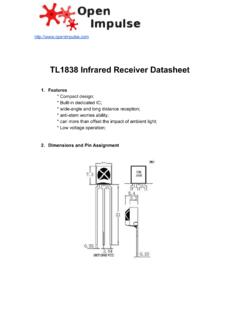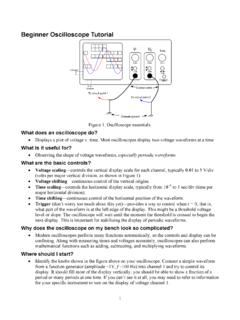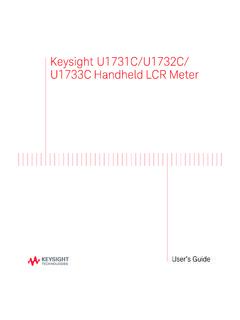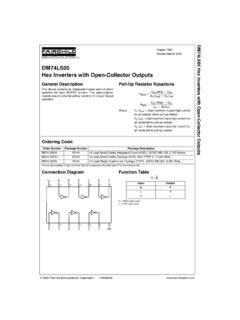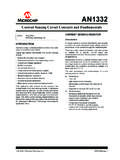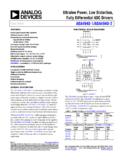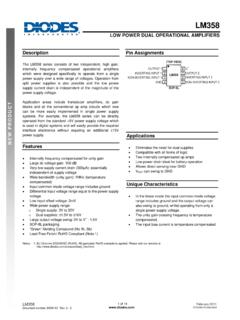Transcription of Measuring relative phase between two waveforms using an ...
1 Measuring relative phase between two waveforms using an oscilloscope Overview There are a number of ways to measure the phase difference between two voltage waveforms using an oscilloscope. This document covers four methods and summarizes the advantages and limitations of each. Method Oscilloscope Requirements Waveform Requirements Advantages Limitations Time-difference 2 channels B a Lissajous 1 v. 2 mode Sinusoidal only D, E a, c Product 1 2 mode Sinusoidal only A a, b Curvefitting 2 channels Data connectivity A, B, C, D d a: Errors introduced when dc offsets are present b: Reduced precision near = 0 , 180 c: Reduced precision near = 90 , 270 d: Possible incorrect solution A: No manual reading of values from display (can be automated) B: Works with nonsinusoidal waveforms C: Uses entire waveform information to increase accuracy D: Cool E: No need to measure time scales Explanations are given to show how each method works.
2 These are given for reference, but understanding them is not necessary to apply the methods. Measuring relative phase between oscilloscope traces using the time-difference method Requirements: Oscilloscope: Two channels (Includes virtually all oscilloscopes.) waveforms : Common frequency and shape Method: Display both channels as a function of time. Scale each voltage channel so that each waveform fits in the display. Ground or zero each channel separately and adjust the line to the center axis of the display. Return to ac (Optional) If you can continuously adjust the voltage per division, scale your waveforms to an even number of divisions. You can then set the zero crossing more accurately by positioning the waveform between gridlines on the display.
3 Pick a feature ( , peak or zero crossing for sinusoids, rising or falling transition for square waves) to base your time measurements on. The peak of a sinusoid is not affected by dc offsets , but is harder to pinpoint than the zero crossing. Then follow one of the methods below: Method 1 Method 2 (requires continuous time base scaling) Measure the period T between repeats. Digital scopes often measure f = 1 / T automatically. Measure td, the smallest time difference between occurences of the feature on the two waveforms . The phase difference is then Ttd = 36012 Fit one period of your waveform to 4, 6, or 9 divisions. Scale the time base by a factor of ten (expand the plot horizontally), so that each division will be 9, 6, or 4 , respectively.
4 Count the number of divisions between similar points on the two waveforms . Figure 1. Dual-channel display. With either method, the sign of is determined by which channel is leading (to the left of) the other. In the figure, v1 leads v2. Measuring relative phase between oscilloscope traces using the Lissajous (ellipse) method Requirements: Oscilloscope: Able to display the voltage of one channel vertically and the other channel horizontally. (Includes virtually all oscilloscopes.) waveforms : Sinusoidal Common frequency Method: Set the oscilloscope to xy mode. Scale each voltage channel so that the ellipse fits in the display. (This may be a line if the phase difference is near 0 or 180 .) Ground or zero each channel separately and adjust the line to the center (vertical or horizontal) axis of the display.
5 (On analog scopes, you can ground both simultaneously and center the resulting dot.) Return to ac coupling to display the ellipse. (Optional) If you can continuously adjust the voltage per division, scale your waveforms to an even number of divisions. You can then center the ellipse more accurately by positioning the waveform between gridlines on the display. Measure the horizontal width A and zero crossing width C as shown in the figure to the right. The magnitude of the phase difference is then given by ()()[] = QIIin ellipse of top/sin180 QIin ellipse of top/sin1112 ACAC The sign of ()12 must be determined by inspection of the dual-channel trace. Figure 2. Lissajous figure. (by Paul Kavan) Explanation: Given two waveforms : v1 vertical, v2 horizontal ()()()()222111coscos + = + =tVtvtVtvpp The ellipse will cross the horizontal axis at time t0 when v1(t0) = 0 or + = += + 101021121ntnt At this time the value of v2(t0) will be () + +=2120221cosnVtvp A trig identity yields* () = + sinsincoscoscos ()() + =even is if odd is if sin12above/202nnVtvACp321 Now we have two nasty details to take care of.
6 First, we have to be careful taking the inverse sine, since a phase change between 90 and 180 gives rise to the same (C / A) ratio as its coangle. To decide which we have, find the times tp1 and tp2 when v1(t) and v2(t) peak: = = + 11110pptt And look at ()tv2 at that time: ()()12212cos =ppVtv Conversely ()()()12121121coscos = =pppVVtv So if v2 is positive when v1 is maximum positive if | 2 1| is between 0 and 90 . For this case, the top and right side of the ellipse will be in Quadrant I. But if v2 is negative when v1 maximum positive, then we need the other angle with the same sine. This means the top of the ellipse will be in Quadrant II and the right side in Quadrant IV. So if > 9012, then the actual inverse sine is ()[]AC/sin1801 , where sin-1 represents the principle inverse sine between 0 and 90.
7 Second, what is the sign of ()12 ? Suppose we have a case where two voltages ()tv1' and ()tv2' have the same amplitudes as before but with opposite phase angles: ()()()()222111cos'cos' = =tVtvtVtvpp Since () ( ),coscos = ()()[]()( )[]222111cos'cos' + = + =tVtvtVtvpp This is the exact same as ()tv1 and ()tv2, but reversed in time. The Lissajous figure will look exactly the same, but the trace will precess in the opposite direction. That means the sign of the phase difference cannot be determined in xy mode. So we need the dual-channel trace to determine the sign of ()12 . Measuring relative phase between oscilloscope traces using the product method Requirements: Oscilloscope: Automatic amplitude measurement (preferably rms value) for each channel.
8 Display the product of the two channels and calculate its dc offset automatically. This method was developed using the Tektronix 2012B oscilloscope. waveforms : Sinusoidal Common frequency Method: Display the two traces in voltage v. time mode, along with the product trace in voltage2 v. time mode. Use ac coupling. Fit the traces in the screen vertically. Display the MEAN value (dc offset vmath,dc) of the product trace. Show about 10 of its periods to ensure that the calculation is not affected by partial waveforms at the beginning and end of the trace. You may also want to average the sampling to reduce error. Display the rms amplitude of each of the channels (V1rms and V2rms). using rms (rather than peak-to-peak) means that the scope has averaged over the waveform.
9 The phase difference is then* ()ppppdcmathppdcmathrmsrmsdcmathVVvVVvVV v === 21,21,21,1282cos The sign of ()12 still has to be determined by inspection of the dual-channel trace. Explanation: Given two waveforms : ()()()()222111coscos + = + =tVtvtVtvpp Their product is ()()( )2121coscos + + =ttVVtvppmath Applying the trig identity ()()2coscoscoscos + + = yields ()()()[]2121212coscos2 + + + =tVVtvppmath The phase difference determines the dc offset of the math trace: ()2121,cos2 =ppdcmathVVv *This method is least precise when the phase difference is nearly 0 or 180 , cases where cos is not sensitive to . Figure 3. Oscilloscope display for the product method showing the dual-channel display and the product trace, along with the values for V1rms, V2rms, and vmath,dc as calculated by the oscilloscope.
10 Here ()[] = = Since the peak in channel 2 is to the left of the peak in channel 1, v2 leads v1. Figure 4. Spreadsheet used for curvefitting method. Regions are color coded according to function: instructions, preference, data, results, error figure ( between guess and experiment), parameter guesses (calculated from data), fit parameters. Approximate values of the fit parameters must supplied before using the Solve function. Measuring relative phase between oscilloscope traces using the curvefitting method Requirements: Oscilloscope: Dual channel capability Capability to transfer data points to a computer This method was developed using the Tektronix 2012B oscilloscope. It has been implemented using OpenChoice Desktop software and an Excel spreadsheet called waveforms : Common frequency and shape Method: Display the two traces in voltage v.
